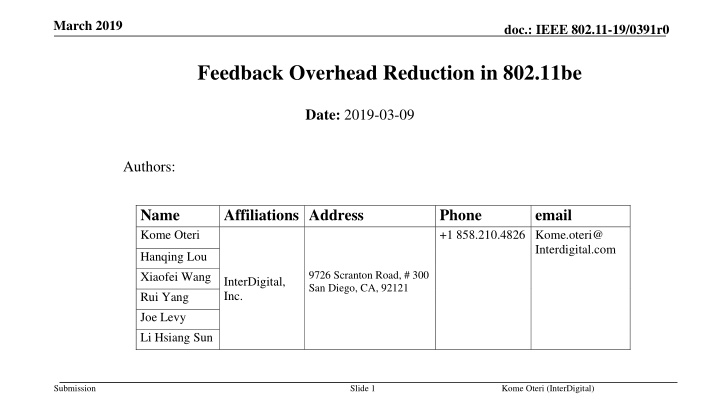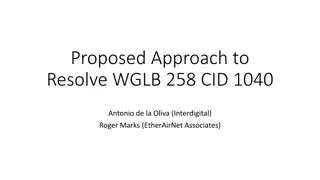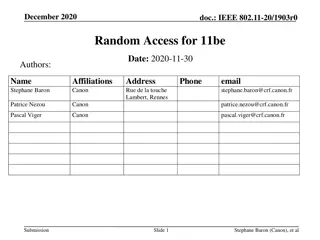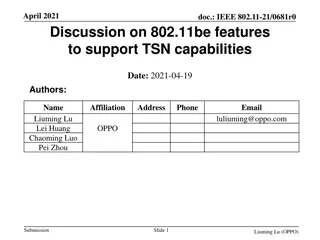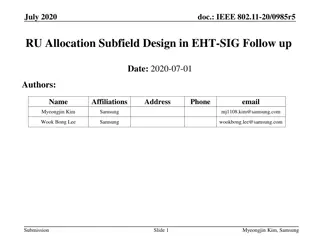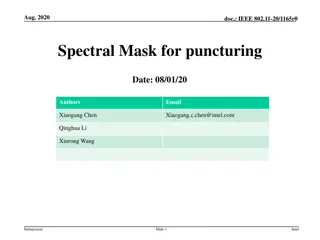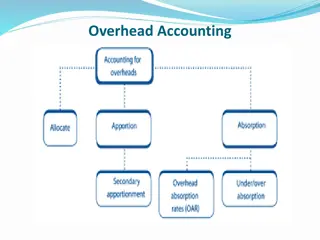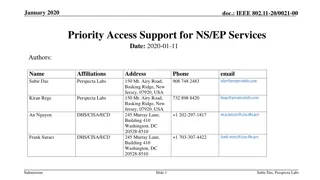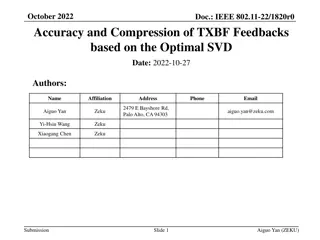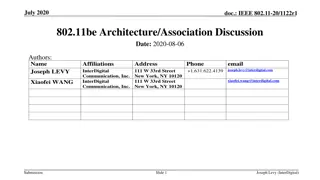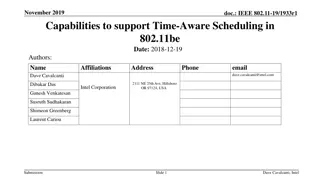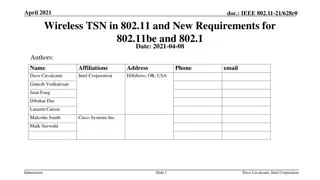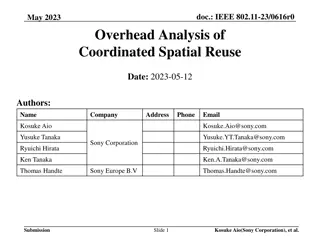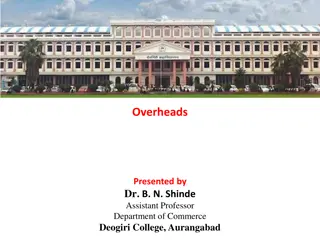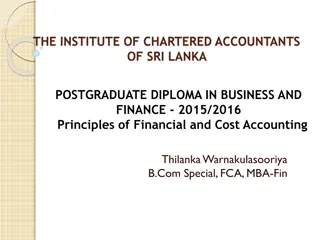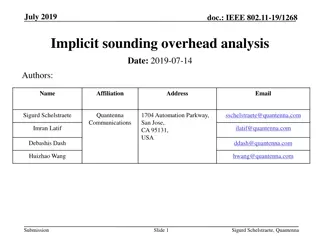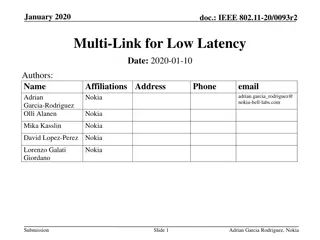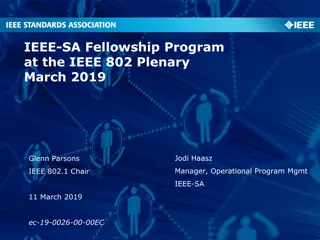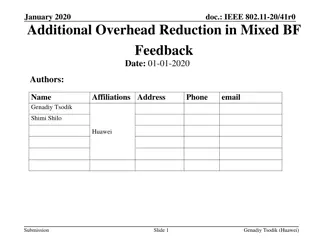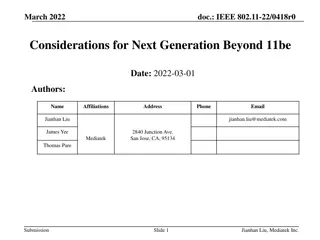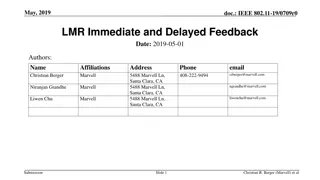Reduction of Feedback Overhead in IEEE 802.11be
Discussion on reducing channel acquisition overhead to support 16 Spatial Stream MIMO and Multi-AP coordination in IEEE 802.11be. Methods include limiting feedback information, using implicit feedback in reciprocal systems, and improving explicit and implicit feedback schemes.
Download Presentation

Please find below an Image/Link to download the presentation.
The content on the website is provided AS IS for your information and personal use only. It may not be sold, licensed, or shared on other websites without obtaining consent from the author.If you encounter any issues during the download, it is possible that the publisher has removed the file from their server.
You are allowed to download the files provided on this website for personal or commercial use, subject to the condition that they are used lawfully. All files are the property of their respective owners.
The content on the website is provided AS IS for your information and personal use only. It may not be sold, licensed, or shared on other websites without obtaining consent from the author.
E N D
Presentation Transcript
March 2019 doc.: IEEE 802.11-19/0391r0 Feedback Overhead Reduction in 802.11be Date: 2019-03-09 Authors: Name Kome Oteri Affiliations Address Phone +1 858.210.4826 Kome.oteri@ email Interdigital.com Hanqing Lou Xiaofei Wang Rui Yang Joe Levy Li Hsiang Sun 9726 Scranton Road, # 300 San Diego, CA, 92121 InterDigital, Inc. Submission Slide 1 Kome Oteri (InterDigital)
March 2019 doc.: IEEE 802.11-19/0391r0 Abstract In this contribution, we discuss methods to reduce the overhead of channel acquisition at the transmitter to assist in 16 Spatial Stream MIMO and Multi-AP coordination in 802.11be. Submission Slide 2 Kome Oteri (InterDigital)
March 2019 doc.: IEEE 802.11-19/0391r0 Introduction The use of 16 spatial streams has been discussed as a possible feature for 802.be [1]. Preliminary simulation results show performance benefits in increasing the number of spatial streams [2]. However, this comes with an attendant increase in the amount of sounding and feedback needed. Multi-AP coordination has also been discussed as a possible 802.11be feature [1] [15]. Preliminary results also show some performance benefits [15]. However, this may require an increase in the feedback needed as a STA may send feedback to each of the APs in the multi-AP set. To reduce the overhead required it has been suggested that: Feedback overhead be reduced by limiting the amount of information fed back while ensuring no performance loss [5] Feedback overhead be eliminated in reciprocal systems by using implicit feedback methods [7] This contribution discusses both features with information on the following: Improvement of existing explicit and implicit feedback schemes New explicit feedback schemes Submission Slide 3 Kome Oteri (InterDigital)
March 2019 doc.: IEEE 802.11-19/0391r0 Feedback in 802.11 Both implicit and explicit feedback have been specified in 802.11 802.11n [3] supports (a) implicit feedback, (b) explicit MIMO non-compressed feedback and (c) explicit MIMO compressed beamforming feedback 802.11ac [3] supports explicit MIMO compressed beamforming feedback only with 802.11n as baseline. 802.11ah [8] supports explicit feedback with 802.11ac as a baseline and simplification of the N x 1 feedback case 802.11ax [4] supports explicit feedback with 802.11ac as a baseline and Large Ng: Increase the tone grouping size {Ng} during feedback Partial Bandwidth Feedback: Allows feedback over a range of RUs. CQI based feedback: Allows feedback of the SNR of an RU 802.11ad [3] supports explicit time domain feedback 802.11ay [9] uses 802.11ad as baseline and supports explicit MIMO compressed beamforming feedback with 802.11ac as baseline for hybrid beamforming We will discuss the improvement schemes for 802.11be from this set of schemes. Submission Slide 4 Kome Oteri (InterDigital)
March 2019 doc.: IEEE 802.11-19/0391r0 Explicit Feedback Reduction (Improvement Schemes) For explicit feedback reduction, we may improve the current beamforming feedback methodologies in 802.11 using any one of the following: 1. 2. 3. 4. Only Feedback: Feed back only in N x 1 transmission and assume a fixed (802.11ah) [5] Time Domain Channel Feedback (802.11ad/ay) [3] Differential Given s Rotation : Feed back time or frequency difference in Given s Rotation angles [6] Variable Angle Quantization : Use different quantization levels for different Given s rotation angles ( i, i) where ( , ) are the angles of the premultiplication matrices and Given s rotation matrices used in compressing the right singular matrix of the channel for feedback Submission Slide 5 Kome Oteri (InterDigital)
March 2019 doc.: IEEE 802.11-19/0391r0 Only Feedback Feed back only in N x 1 transmission and assume a fixed as in 802.11ah [8] 802.11ah supports feedback of ? angles only with single data stream transmissions. The values of are fixed [8, 24.3.10.2] Reduction in overhead is shown in the tables below (methodology in [14]) We may keep the overhead the same and increase b . (Table 1 and 2) We may reduce the overhead by keeping b the same and changing b (Table 1 and 3) Submission Slide 6 Kome Oteri (InterDigital)
March 2019 doc.: IEEE 802.11-19/0391r0 Time domain channel feedback Feed back time domain channel as in 802.11ad/ay [9] The number of significant taps may be much less than the number of tones and may result in feedback overhead savings. However, we may need to feed back the actual channel or the SVD components of the channel (U, S and V matrices) to enable transformation of the channel to the frequency domain. This may increase the number of matrices fed back It may be necessary to indicate the position of the channel taps as they are not fixed as in frequency domain feedback. Therefore, there is a trade-off between increasing the feedback per tap and the smaller number of taps fed back in reducing the feedback overhead. Submission Slide 7 Kome Oteri (InterDigital)
March 2019 doc.: IEEE 802.11-19/0391r0 Differential Given s Rotation Feed back time or frequency difference in Given s Rotation angles Send differential information between Given s rotation angles of baseline channel and next channel in time [10], frequency or frequency subcarrier indices (802.11ay) [9]. e.g. in the frequency domain, we can use scalar difference (subtraction) between the angles as shown below. H(k) {f(k), y(k)} Givens decomp. Original quantization Empirical CDF Empirical CDF 1 1 - H(k+4) 0.9 {df, dy} Channel B+D+E Channel B only {f(k+4), y(k+4)} Givens decomp. Differential quantization 0.9 + 0.8 0.8 0.7 0.7 0.6 0.6 F(x) 0.5 F(x) 0.5 0.4 0.4 Channel B+D+E Channel B only 0.3 0.3 0.2 0.2 0.1 0.1 0 0 -1 -0.8 -0.6 -0.4 -0.2 0 0.2 0.4 0.6 0.8 1 -0.5 -0.4 -0.3 -0.2 -0.1 0 0.1 0.2 0.3 0.4 0.5 radians radians CDF of _ with a frequency separation of 4 sub-carriers with 312.5 kHz separation CDF of _ with a frequency separation of 4 sub-carriers with 312.5 kHz separation. Submission Slide 8 Kome Oteri (InterDigital)
March 2019 doc.: IEEE 802.11-19/0391r0 Variable Angle Quantization Use different quantization levels for different Given s rotation angles ( i, i). Angle may vary over the distribution; for example the range of 1is greater than the range of 7 for an 8 x 8 system as shown below. To quantize the angles after Givens rotation, we may use different ranges for different angles or groups of angles: For each angle or groups of angles, the range = ?,? 0,?/2 . Submission Slide 9 Kome Oteri (InterDigital)
March 2019 doc.: IEEE 802.11-19/0391r0 Explicit Feedback Reduction (New Schemes) Multiple component feedback: splits feedback into multiple components [5][11] One component has a larger size and is fed back at longer intervals. One component is smaller and is sent back at shorter intervals. The combination of both may reduce the overall feedback Examples include (1) Feed back long term / short term information or (2) Feed back wideband / sub- band information Codebook-based feedback: Feed back codeword from a well designed codebook [12] Overall feedback may reduce based on the size of the codebook. Two way channel training [13] The transmitter sends out its training signal, the receiver repeats its received signal back to that transmitter. From this round-trip training signal, together with the one way training signal from the receiver, the transmitter is able to estimate its own outgoing channel Submission Slide 10 Kome Oteri (InterDigital)
March 2019 doc.: IEEE 802.11-19/0391r0 Implicit Feedback Bfer solicits packets suitable for channel estimation in the reverse direction [7] Avoids overhead of the CSI feedback but needs calibration to compensate for any variations in reciprocity. Implicit feedback and calibration were specified in 802.11n [4] and should be used as baseline. May need to update to enable uplink MU-sounding [7] For MU-MIMO, there is a trade-off between implicit and explicit feedback depending on the number of STAs, the duration of the feedback and the duration of the uplink sounding frame e.g. as the number of STAs increases, the number of frames transmitted in the uplink also increases as shown in the figure below. This implies both implicit and explicit feedback should be considered in the discussion. Sequential implicit feedback [7] Kome Oteri (InterDigital) Submission Slide 11
March 2019 doc.: IEEE 802.11-19/0391r0 Pros and Cons Scheme Pros Cons 1 only feedback exists in 802.11ah single data stream only may need additional signaling to identify tap positions and the extra matrix 2 time domain channel exists in 802.11ad/ay Simple improvement from 802.11ax, variant in 11ay 3 Differential Givens Rotation Additional processing, Error Propagation 4 Variable Angle Quantization simple improvement from 802.11ax additional processing Well understood, reduced feedback overhead Well understood, reduced feedback overhead Do not need calibration, reduced feedback overhead 5 Multi-component Feedback May need additional design 6 Codebook based Feedback May need additional design 7 Two way channel training May need additional design 8 Implicit Feedback Simple improvement from 802.11n Needs calibration Submission Slide 12 Kome Oteri (InterDigital)
March 2019 doc.: IEEE 802.11-19/0391r0 Conclusions In this contribution, we have discussed methods to reduce the overhead of channel acquisition at the transmitter to assist in 16 Spatial Stream MIMO and Multi-AP coordination in 802.11be. We discussed both explicit and implicit feedback methods by which the channel acquisition overhead may be reduced. For explicit feedback, we discussed simple improvements to 802.11ax explicit feedback as well as schemes new to 802.11. For implicit feedback, we highlighted the need for an update to the 802.11n methods. Submission Slide 13 Kome Oteri (InterDigital)
March 2019 doc.: IEEE 802.11-19/0391r0 References 1. 11-19/244r0 EHT PAR document, Michael Montemurro (BlackBerry) 2. IEEE 802.11-18/0818r3, 16 Spatial Stream Support in Next Generation WLAN, Sameer Vermani (Qualcomm) 3. IEEE P802.11-REVmdTM/D2.1, February 2019, Draft Standard for Information technology telecommunications and information exchange between systems, Local and metropolitan area networks, Specific requirements 4. IEEE P802.11ax /D4.0, February 2019, (amendment to IEEE P802.11REVmd/D2.0) 5. IEEE 802.11-18/1184r1, EHT discussions on throughput enhancement, Tianyu Wu (Samsung) 6. IEEE 802.11-15/1321r2, Reducing Explicit MIMO Compressed Beamforming Feedback Overhead for 802.11ax Kome Oteri (InterDigital) 7. IEEE 802.11-18/1191r0, MU sounding improvements, Sigurd Schelstraete (Quantenna) 8. IEEE P802.11ah /D2.0 Amendment 6: Sub 1 GHz License Exempt Operation 9. IEEE P802.11ay /D3.0, February 2019 , (amendment to IEEE P802.11REVmdTM/D2.1 as amended by IEEE P802.11ax /D3.3) 10. Porat, R.; Ojard, E.; Jindal, N.; Fischer, M.; Erceg, V., "Improved MU-MIMO performance for future 802.11 systems using differential feedback," in Information Theory and Applications Workshop (ITA), 2013 , vol., no., pp.1-5, 10-15 Feb. 2013 11. Chaiman Lim; Taesang Yoo; Clerckx, B.; Byungju Lee; Byonghyo Shim, "Recent trend of multiuser MIMO in LTE-advanced," in Communications Magazine, IEEE , vol.51, no.3, pp.127-135, March 2013 12. Love, D.J.; Heath, R.W.; Lau, V.K.N.; Gesbert, D.; Rao, B.D.; Andrews, M., "An overview of limited feedback in wireless communication systems," in Selected Areas in Communications, IEEE Journal on , vol.26, no.8, pp.1341-1365, October 2008. 13. L. P. Withers, R. M. Taylor and D. M. Warme, "Echo-MIMO: a two-way channel training method for matched cooperative beamforming," IEEE Trans. Signal Process., vol. 56, no. 9, pp. 4419-4432, Sep. 2008. 14. IEEE802.11-16/0030r1, Maximum Tone Grouping Size for 802.11ax Feedback with MU-MIMO, Kome Oteri (InterDigital) 15. IEEE802.11-18/1926r2, Terminology for AP Coordination, Sameer Vermani (Qualcomm) Submission Slide 14 Kome Oteri (InterDigital)
